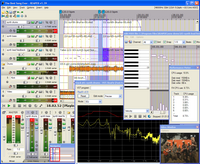ReaperAbout
From CockosWiki
Main Page > REAPER Documentation
This page needs updating.
update and clean-up
Please update the page (How to edit a page?)
If you have updated the page, or examined it and found the information up-to-date, please remove this box.
Contents |
Notable Features of REAPER
About
REAPER is a powerful application for multitrack recording and editing of audio that runs on Windows and Mac OSX. REAPER provides a flexible but easy to use interface that is suitable for amateurs and professionals alike.
REAPER is reasonably priced, uncrippled unexpiring shareware.
Basic features
- Supports ASIO, Kernel Streaming, WaveOut (MME) and DirectSound (WDM) for playback and recording
- Reads and records WAV, OGG, AIFF, Wavpack, FLAC, APE, MP3 (with the lame encoder) and MIDI files, as well as many other formats.
- Lets you arrange any number of items in any number of tracks
- Supports real-time audio processing plug-ins (DirectX, VST, and Jesusonic) with automation
- Volume, pan controls and envelopes per track
- Multi-layer undo/redo support
- User creatable color themes
- Supports VSTi and DXi soft synths
Advanced features
- Unlimited send/receives per track
- Any track can act as a bus or auxilliary
- Folder tracks that can contain and group tracks
- Item grouping
- Markers
- Multiple takes per media item
- Auto punch-in/punch-out functionality
- Automatic record monitoring modes
- Selection length granularity options as well as grid snapping
- A UI and architecture that allows you to easily cut loops of many tracks simultaneously, without having to write them to disk
- Support for plug-in generated media (such as click tracks, etc)
- Project tempo envelopes for variable tempos in track, grid/snapping that supports variable tempos
- 64-bit floating point sample pipeline for high quality
- Advanced recording and monitoring options -- examples:
- You can route multiple tracks (inputs and/or media items) into a bus and record THAT mixed down version.
- You can record the input signal, or record the post-FX, post-track-rendered signal.
- You can switch recording sources on the fly, even while recording.
- You can arm/disarm tracks' inputs while playing or recording.
- Record any render at any sampling rate / 16, 24 or 32 bit
- Multiple hardware outputs per track/channel
A sampling of qualities that makes REAPER sensible
- Sane, human readable, backwards and forwards compatible project file format
- Options to build peaks for recorded files on the fly
- Lots of control for the user to specify where recorded files go, etc, when dealing with many projects.
- Template support to make it easy to load a project template and save it as a new project when you begin.
- Input channel name aliasing (why view your inputs as "MOTU 896: Analog 1" when you could have them be "Vocal Mic", etc).
- Options for automatically backing up project files to alternate paths, timestamped versions, etc.
Main Page > REAPER Documentation
